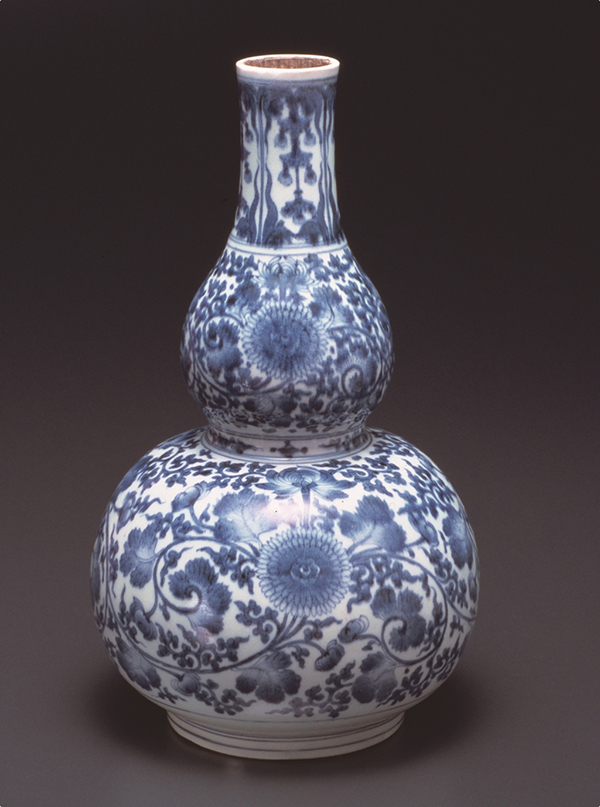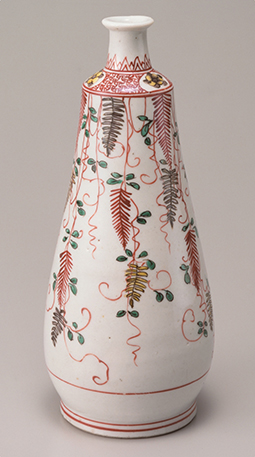 |
Focus features two in-depth reviews each month of fine art, architecture and design exhibitions and events at art museums, galleries and alternative spaces around Japan. The contributors are non-Japanese residents of Japan. |
|
|
 |
 |
 |
Nature on the Table: Flower and Plant Designs in Imari Ware
J.M. Hammond |
 |
It is something of a truism that a keen fondness for nature is reflected in the art, poetry, cuisine and other aspects of Japanese culture. In the arena of pottery, nowhere is the love of flowers and plants as pronounced as in Imari ware, a type of porcelain first produced in the early 17th century.
Flower and Plant Designs in Imari Ware, an exhibition that can be seen in Tokyo until 22 September, explores how the motif of nature runs through the roughly 80 Imari pieces on display, all from the Edo period (1603-1867). The show is being held in the sleepy Shoto neighborhood of Shibuya at the Toguri Museum of Art, which is dedicated to Asian ceramics.
Production of Imari became a worldwide business from the middle of the 17th century, when a gap opened up in the European market. At that time, internal chaos in China disrupted the country's porcelain production and trade, which had hitherto dominated exports from Asia to Europe.
Imari ware acquired its name from the port town of Imari on the southern Japanese island of Kyushu, from where these goods were shipped to Nagasaki (the only place in the country then open to international trade) for export to Europe. Production, however, actually took place in the town of Arita in the same region (known today as Saga Prefecture), often in the same kilns that gave us Arita ware.
Imari shares the vibrant blue underglaze that is a hallmark of Arita, but as the technical knowledge to fire rich reds, golds, and other hues was developed, later Imari made full use of these colors. Also, much Imari has a tendency toward elaborate designs that sometimes cover the entire surface with painted decoration, which some connoisseurs have described as overly fussy. But this was an era when the ornate was all the rage in Europe, and Imari ware ended up as showpieces in many a castle and palace there.
 |
|
 |
|
|
|
|
Gourd-shaped bottle, decorated with floral arabesque design in underglaze blue. Imari ware, Edo period, late 17th to early 18th century. Toguri Museum of Art
|
|
Bottle, decorated with pine tree, bamboo and plum design in underglaze blue and overglaze enamels. Imari ware in Ko-Kutani style, Edo period, mid-17th century. Toguri Museum of Art |
While these works were certainly made with one eye on the export market, they also sold domestically and fully explored Japanese themes, or those originally brought in from China. Dishes and bowls frequently featured motifs of seasonal plants and flowers, such as cherry blossoms and peonies, which were also auspicious symbols.
One popular design is the chrysanthemum, a symbol of long life. A set of five plates comes with quotes from a poem often recited at an annual chrysanthemum festival, so it is believed they were made especially for that occasion. As becomes apparent throughout the exhibition, the reference to a particular flower or plant is found not only in the painted design, but in the actual shape of the product itself. In this set, the rim of each dish evokes the outline of the chrysanthemum flower. Elsewhere, an elegant set of small dishes in the shape of myoga, the edible part of a member of the ginger family, celebrates that auspicious plant, whose name is a homonym for the word for "divine protection."
|
 |
|
|
|
Bottle, decorated with wisteria design in overglaze enamels. Imari ware, Edo period, late 17th century. Toguri Museum of Art
|
Usefully, the exhibition often groups items with the same motif together. One example is the gourd, which symbolizes good fortune as well as fertility (as do many fruits with lots of seeds, such as pomegranates). It appears not only as a painted design on a set of teacups, but also in the shape of various bottles and dishes placed nearby. One of these takes pride of place as an exhibition highlight in its own glass case -- a gourd-shaped bottle completely covered with a floral arabesque design in a deep underglaze blue.
|
Chrysanthemum-shaped bowl, decorated with dragon, flower and geometric design in underglaze blue, overglaze enamels and gold. Imari ware, Edo period, late 17th to early 18th century. Toguri Museum of Art
|
A number of the exhibits boast such intricate interlocking designs, and there is a range of them, including "whirlpool" and "octopus" arabesques. These were originally given the role of decorating the underside of dishes and bowls, but over time they were also employed in the main design. Usually just one such arabesque would be chosen for one piece of porcelain, so the liberal use of two (the floral and octopus) on two bowls, originally from a set of five, is unusual.
One nature motif that appears frequently is the combination of pine, bamboo and plum. This image of the "three friends of winter" came to Japan from China, where they had long been a symbol of perseverance and resilience, as all three survive the harsh winter. They feature here in a range of items, including a dish where the pine tree is placed in the center with an arabesque surround.
|
Myoga-shaped dishes, decorated in underglaze blue. Imari ware, Edo period, late 17th century. Toguri Museum of Art
|
If your taste veers toward the more understated side of Japanese aesthetics, there are also simple designs making ample use of empty space that may appeal. With one dish the main design (a bamboo motif in underglaze blue) is not placed in the middle but at the edges, leaving the center open to reveal the white porcelain for a pleasing, refined effect. There are also a number of pieces in celadon green that afford a break from the usual deep blues and reds, as well as many more flower and plant motifs than can be mentioned here.
As with the bamboo, the pine and the plum, Imari ware itself has proven to be resilient, still enjoying popularity today after centuries of changing tastes. So whether you are an Imari devotee or would just like to see some elegant porcelain, persevere through the beating summer sun of Tokyo and head for Flower and Plant Designs in Imari Ware. Your senses will be rewarded.
All images are courtesy of the Toguri Museum of Art. |
 |
 |
J.M. Hammond
J.M. Hammond researches modernity in Japanese art, photography and cinema, and teaches in Tokyo, including as a faculty lecturer in the English department at Meiji Gakuin University. He has written about art for The Japan Times for over a decade. His essays include "A Sensitivity to Things: Mono No Aware in Late Spring and Equinox Flower" in Ozu International: Essays on the Global Influences of a Japanese Auteur (Bloomsbury, 2015) and "The Collapse of Memory: Tracing Reflexivity in the Work of Daido Moriyama" for The Reflexive Photographer (Museums Etc, 2013) [reprinted in the same publisher's 10 Must Reads: Contemporary Photography (2016)]. He has given various conference papers, including at the University of Hong Kong and the University of Oxford. |
|
 |
|